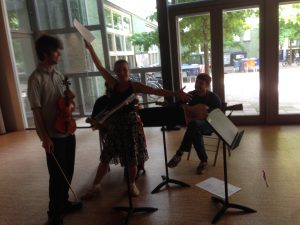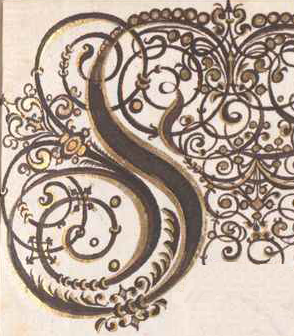FOMU Dance workshop 2
Improvising for Rachel’s dance workshop day 2 – Allemande
 At the Festival Oude Muziek Utrecht The Scroll Ensemble joins Rachel Farr for her dance workshops. The Scroll Ensemble is perfectly fitted to this task, since dance musicians often improvised on the music for the dancers, or even all the music. Many dance pieces were consequently also favourite improvisation standards and vice versa, many improvisation favourites had titles to do with dancing, such as the “Ballo del Gran Duca” (Ballo meaning dance).
At the Festival Oude Muziek Utrecht The Scroll Ensemble joins Rachel Farr for her dance workshops. The Scroll Ensemble is perfectly fitted to this task, since dance musicians often improvised on the music for the dancers, or even all the music. Many dance pieces were consequently also favourite improvisation standards and vice versa, many improvisation favourites had titles to do with dancing, such as the “Ballo del Gran Duca” (Ballo meaning dance).
In the following we present a playlist of the music. Sometimes we have also found links so you can listen to a version of the music! We are always happy with your support (find out here about the many ways you can support us) or your comments.
Day 1 – Basse Danse
Day 2 – Allemande (click here to go to day 2)
Day 3 – Balletto detto l’Alemana (click here to go to day 3)
Allemande
We can see that people danced in what is now called Germany from several sources. For example, a dance room was built for the nobility and rich merchants in Nördlingen in 1444. We can also find dance music in printed sources, such as the Buxheimer Orgelbuch.
Through this kind of sources we can find that the Allemande originates in 1540 Nürnberg as Deutscher Tanz. In other countries it was known as Almande (France), Balletto tedesco (Italy) or Almain (Great Brittain). Unfortunately there is little evidence describing the actual dance (moves). Thoinot Arbeau’s Orchésographie
An Wasserflüssen Babylon
We repeat the first day’s opening piece with different improvisations. Read more about it in the first day’s post.
Johann Jakob Walther – Hortulus chelicus, Mainz, 1688
17th Century musicians, especially violinists, experimented with their instruments. They crossed their strings, experimented with sounding like birds, other instruments, invented new playing techniques like playing more than one string, pizzicato, etc.
It was also the century when the violin rose to prominence as the ‘queen of instruments’. First in Italy with violinists like Biagio Marini and Marco Uccellini, who paved the way for Arcangello Corelli. In the German-Austrian regions we are nowadays most familiar with Franz Ignaz Biber, but Johann Jakob Walther was an equally famous violin virtuoso in his time.
James performs Leuto harpeggiante e rossignuolo in which the violin and cello play pizzicato to imitate a lute and play with motives from bird song. We are interested in written music as well, as an inspiration for our improvisations. The written compositions show some record of how ‘they’ may have improvised.
A little snippet from our rehearsal:
Michael Praetorius – Terpsichore
Michael Praetorius was the most versatile and wide-ranging of his German generation. Specifically in the area of works based on protestant hymns (like An Wasserflüssen Babylon) he is of notable interest.
Praetorius also published an important theoretical work, called Syntagma Musicum. In it he describes the current musical practices, shows as one of the earliest treatises the influence of the recent Italian developments (“Caccini;s” monodic style) and gives an overview of all the instruments, many of which are now not in use anymore. In this sense the treatise clearly stands in the German tradition of for example Martin Agricola.
In his vocal publications Praetorius also leaves interesting documentation for improvisers, as his is an early example of publishing both an unornamented and an ornamented version next to each other.
The collection Terpsichore (1612) is his only extant instrumental work. According to his own writings he planned this to be a collection in 8 parts, also including vocal music, but sadly the other parts never got published.
Thoinot Arbeau – Orchésographie
Orchesographie is probably the best known dance manual before 1600. It is also easier to use than its Italian counterparts, as the dance steps are notated with the music instead of in prose separately from the musical notation.
Interestingly Thoinot Arbeau was a priest and as such was perhaps an exception in not only allowing dance, but even describing its practices. Certainly compared to the protestant practices, where dance was generally condemned. Specifically Calvijn took to it very harshly!
In the practice of several treatises of the time and inspired by the Greek philosophers, the treatise is written down as a conservation between the teacher and a student who is lacking in social connections and told to learn to dance in order to change this.
An interesting point about this treatise is also that a few of the choreographies are related specifically to theatre pieces of the time, such as the Bransle de Poictou we use today.
Tielman Susato – Het derde musyck boexken … alderhande danserye (1551)
Tielman Susato‘s origin is not known and therefore some people have argued he may be from the town Soest.
He became the first music publisher in the Netherlands and also composed. He might be most famous for publishing the Souterliedekens by Clemens non Papa, Dutch psalm settings.
In Het derde musyck boexken (the third music book) we find his own compositions and arrangements. Here a piece in a rather extraordinary version for crumhorns, a ‘capped double reed instrument’.
Ballo del Gran Duca
This piece is also called “Aria di Firenze” and was popular. Several variation pieces on it exist today, and Frescobaldi even wrote a mass using this material! This piece has been with us for a long time and we even played it for a scene in the movie “Michiel de Ruyter” for the English King, played by Charles Dance! (In the end, we didn’t make it to the final cut in that particular scene… ).
Onder den Linden Groene
This song has an English origin. The oldest known setting can be found in the lute book of William Ballet, but it may be much older than this end of 16th-century publication. Interestingly Jacob van Eyck’s version of this song uses another melody, namely “The Lord Zouche’s Masque”. This is the only time these two pieces got mixed up.
Sweelinck also knew about this song and composed the following variations.
